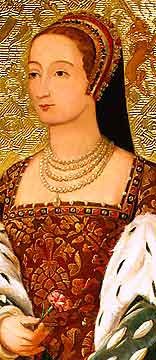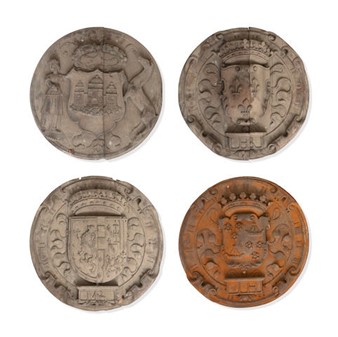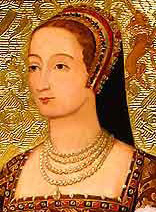A talk by Dr Anna Groundwater, National Museum of Scotland was held on 14th March 2024 at the Holy Trinity Church, Church Road, Haddington.
The following is a summary of her talk:
As Principal Curator for Renaissance and Early Modern History, Anna played a major part in acquiring for the museum the four decorative oak roundels which once adorned the rooms of Marie de Guise’s residence in Blyth’s Close, Edinburgh. The roundels reveal much about the power and influence of Marie in Scotland and, through the powerful de Guise family, in Europe. A brief outline of Marie’s life and achievements sets the roundels in their historical context.

Born in 1515, at the age of 11 Marie joined a convent. Her stay was relatively brief because her uncle, the Duke of Lorraine, took her into the French court where she matured into a tall, attractive, intelligent woman with auburn hair and grey eyes and with a ‘charming manner’. In 1534 she entered the first of her two relatively short marriages: to the Duke of Longueville with whom she bore 2 sons. Marie was widowed on the death of her husband in 1537. With the encouragement of the French king, Francis I, Marie was betrothed to James V, and arrived in St Andrews to be married in the summer of 1538 whence followed 40 days of extravagant celebrations in honour of the occasion. She made her formal entry into the city of Edinburgh later in the year. As consort, Marie was guaranteed life-long rights (‘jointure’) to the Palace of Falkland, Stirling Castle, Linlithgow Palace, and other properties, together with substantial land holdings. By 1541 Marie had borne two sons, both of whom died in that year. In 1542, a daughter was born, the future Mary Queen of Scots: not the distant future given that her father died 6 days after her birth and the infant Mary thus became queen.
The Earl of Arran was appointed regent and governed during the turbulent years which followed, including the ‘rough wooing’ when an English invasion sought to force the Scots into accepting a marriage between Mary and Edward VI. Marie supported Arran and helped to maintain the effective alliance with France which eventually led to the withdrawal of the English army. In 1548, during the siege of Haddington, then occupied by an English garrison, Marie and the Scottish government signed the Treaty of Haddington at St Mary’s Abbey in which Mary was betrothed to the French Dauphin. In 1550/51 Marie travelled to France to complete the betrothal arrangements, among other things. On her return to Scotland, she set machinery in motion to replace Arran, buying him off with a French dukedom, and so became Queen Regent in 1554. Her regency lasted until her death at the age of 44 in 1560.

It is thought that Marie spent much of her time in residence at Blyth’s Close off Castle Hill, in the period before her regency 1543-1554. Blyth’s Close no longer exists, having been demolished around 1846 to make way for New College and the Assembly Hall. Its location on the north side of the High Street was roughly opposite the Lawnmarket and, in the mid -16th century, Marie’s house would have been a large, imposing property with gardens and orchards laid out on the slope down to the Norloch. The view to the north would have been open and expansive. In the 1820s and 30s the buildings in the close were in a dilapidated, crumbling state (see illustration) and the High Street was by then crowded with the high tenement buildings with which we are familiar today. Victorian antiquarians took a great interest in old Edinburgh and one among them, Charles Kirkpatrick Sharpe, concerned about the state of the increasingly ruinous Queen Regent’s house, bought all salvageable fixtures and fittings from the tenants. His collection included four carved oak roundels which had formed part of what had been a rich and colourful renaissance décor. By this time the roundels, having been moved from their original positions as ceiling or wall mounts, reapplied elsewhere and whitewashed over several times, had lost almost all trace of their original colours, but the carved coats of arms were (and still are) clear. Sharpe died in 1831 and his huge collection was auctioned off. Much was acquired by the National Museum, but not the roundels. These were purchased by the 2nd Duke of Sutherland. The duke seems to have been toying with the idea of using them as part of the interior décor of Dunrobin Castle. Apparently, they were never put on display in the castle and simply stored away. They finally came to light in a Dunrobin Castle attic sale in 2021, when Dr Groundwater was able to bid for them on behalf of the National Museum of Scotland. Her success cost around £19 000!

The roundels clearly were designed to represent the power and influence of Marie in Scotland and, through her connections with the powerful de Guise family and the French royal court, in France and Europe. Taking the roundels in turn as set out in the illustration, that on the top left bears the arms of the city of Edinburgh and appears to represent her close ties to the civic elite (merchants, lawyers, etc.). The one on the top right depicts the arms of Henry II of France, father-in-law to her daughter Mary, and thus her connection to the Valois dynasty. The bottom left roundel shows the arms of Scotland paired with those of de Guise, with the letters ‘M R’ beneath (Maria Regina), representing her position as Queen with James V. The fourth roundel displays the arms of the Earl of Arran, the first regent to Mary Queen of Scots, a political rival she perhaps wished to keep ‘sweet’.
Thus, we have a picture of a very intelligent, capable woman who, during her first 12 years as widow of James V, had no wish to be ‘sent out to pasture’ in some distant castle or estate, instead remaining close to the centre of the action by living in Blyth’s Close. From here she continued to influence the government of Scotland, partly through her position as Queen Mother and partly through her French connections in the continuation of the Auld Alliance. In addition, she cultivated a fruitful relationship with civic elite of Edinburgh. In modern terms, she was a networker par excellence.
The roundels offer tangible evidence of the importance of this remarkable woman. Physically imposing, charming and clever and, given that she was widowed twice and only one of her five children survived her, she was also tough and resilient. As Queen Regent, Marie led Scotland through the very turbulent period which culminated in the Reformation of 1560, coincidentally also the year of her death.
The roundels are expected to be reunited this summer, with other fittings from Blyth’s Close, in the Burghs displays in the Kingdom of the Scots galleries, National Museum of Scotland.
Peter Ramage

You must be logged in to post a comment.